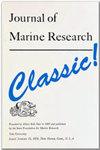Kajian Jenis dan Bobot Sampah Makroplastik di Kawasan Padang Lamun Perairan Pulau Kelapa Dua Kepulauan Seribu Jakarta
IF 0.5
4区 地球科学
Q3 Earth and Planetary Sciences
引用次数: 0
Abstract
Sampah merupakan sesuatu yang terbuang atau dibuang dari sumber hasil aktifitas makhluk hidup dan tidak mempunyai nilai ekonomi. Sampah makroplastik merupakan sampah yang sulit atau tidak dapat terurai oleh mikroorganisme. Sampah dari daratan terbawa ombak ke laut menyebabkan pencemaran. Penelitian ini bertujuan mengetahui pengaruh sampah makroplastik terhadap kondisi padang lamun di perairan Pulau Kelapa Dua, Kepulauan Seribu, Jakarta. Materi penelitian yang digunakan yaitu sampah makro plastik yang diambil di perairan padang lamun dan air yang diambil di area padang lamun. Metode yang dilakukan yaitu persiapan, penentuan stasiun penelitian, pengambilan data, dan analisis data. Pengamatan sampah makroplastik di area padang lamun dilakukan sebanyak 3 kali pengulangan dalam satu stasiun. Hasil penelitian menunjukan bahwa tipe pasang surut di lokasi pengamatan memiliki tipe pasang surut diurnal type. Data kecepatan arus berkisar antara 0,021-0,030 m/s dengan arah arus menuju barat daya, suhu antara 29,5-32,6 oC, kadar salinitas berkisar antara 24-28 o/oo, kadar BOT antara 11,152-35,81 mg/liter, kadar DO antara 5,56-6,25 ppm, dan tingkat kecerahan menunjukan 100% jernih hingga dasar. Berat sampah makroplastik yang ditemukan di seluruh stasiun pengamatan berkisar antara 0,075-2,19 Kg dengan rata – rata ukuran sebesar 8,2-15,6 cm. Persentase penutupan lamun total memiliki nilai 26,77 %, hal ini menunjukan kondisi padang lamun di perairan Pulau Kelapa Dua termasuk kedalam kategori sedang. Garbage is generally something that is wasted or thrown away from the source of the activities of living things and has no economic value. Macroplastic waste is waste that is difficult or even impossible to decompose with the help of microorganisms. Garbage from the mainland will slowly be carried by the waves to the bottom of the ocean which can cause pollution to the ecosystem in the sea. This study aims to determine the effect of macroplastic waste on seagrass conditions in the waters of Kelapa Dua Island, Thousand Islands, Jakarta. The research material used consisted of macro plastic waste taken from seagrass beds, as well as water collected from seagrass beds. The method employed involved the preparation, maintenance of research steps, data collection, and data analysis. Observation of macroplastic waste in the seagrass area was carried out 3 times in one station. The results showed that the tidal type at the observation site had a diurnal tidal type. Current velocity data ranged from 0.021-0.030 m/s with the current direction towards the southwest, temperature between 29.5-32.6 oC, salinity levels ranging from 24-28 o/oo, BOT levels between 11,152-35.81 mg/liters, DO levels are between 5.56-6.25 ppm, and the brightness level shows 100% clear to basic. The weight of macroplastic waste found in all observation stations ranged from 0.075-2.19 Kg with an average size of 8.2-15.6 cm. The percentage of total seagrass cover has a value of 26.77%, this shows that the condition of seagrass beds in the waters of Kelapa Dua Island is included in the medium category.雅加达两千岛灯场水岛大型塑料垃圾类型和炸弹试验
垃圾是一种没有任何经济价值的生物活动的废物或废物。大塑料垃圾是一种很难或无法被微生物分解的垃圾。被海浪冲到海里的垃圾造成了污染。这项研究的目的是确定大塑料垃圾对位于雅加达2000年的椰子群岛2号海域的海草状况的影响。所使用的研究材料是在海带水域捕获的塑料宏观垃圾,以及在海带地区采集的水。方法包括准备、确定研究站、数据检索和数据分析。海草田的宏观垃圾观察在一个车站进行了三次。研究表明,观测地点的潮汐类型具有日潮类型。电流的数据在西南方向的0.021 - 0.030米之间,温度在295 - 32.6 oC之间,盐度在11.152 - 35.81 mg/升之间,DO - 56- 6.25 ppm之间,亮度为100%。在所有监控站中发现的宏观垃圾的重量在0.075 - 2.19公斤之间,平均大小为8.2 - 15.6厘米。海草总值为26.77%,这表明,第二轮椰子岛海域的海草田属于中等类别。Garbage通常是一种浪费或浪费的东西,它远离了生物活动的源头,没有经济价值。生命的质量浪费是困难的,甚至是不可能与微生物的帮助相协调的。来自陆地的卷心菜会慢慢地被埋在海洋的底部,这可能会导致海洋生态系统的污染。这项研究旨在确定果实质量的影响研究中所考虑的关于宏观塑料浪费的研究材料来自海草,就像从海草中收集的水一样。结果包括准备、研究成果、数据收集和数据分析。在seagrass地区观察到的汞浪费在一个车站有三次。建议天文台的潮汐类型是过时的。西南偏南,温度为29.5-32.6摄氏度,16 -32.6摄氏度,16 -32.6摄氏度,1 - 11.5 -32.6摄氏度,机器人的等级为11.152 - 33.8 mg/调解员,5.56-6.25 mg质量waste的重量从0.075-2.19公斤到8.2-15.6厘米不等。总海草覆盖值为26.77%,这表明椰子水域海草的情况包括在介质喂养中。
本文章由计算机程序翻译,如有差异,请以英文原文为准。
求助全文
约1分钟内获得全文
求助全文
来源期刊

Journal of Marine Research
地学-海洋学
自引率
0.00%
发文量
1
审稿时长
3 months
期刊介绍:
The Journal of Marine Research publishes peer-reviewed research articles covering a broad array of topics in physical, biological and chemical oceanography. Articles that deal with processes, as well as those that report significant observations, are welcome. In the area of biology, studies involving coupling between ecological and physical processes are preferred over those that report systematics. Authors benefit from thorough reviews of their manuscripts, where an attempt is made to maximize clarity. The time between submission and publication is kept to a minimum; there is no page charge.
 求助内容:
求助内容: 应助结果提醒方式:
应助结果提醒方式:


